Prolonged Sitting and Knitting: Reversing the Effects
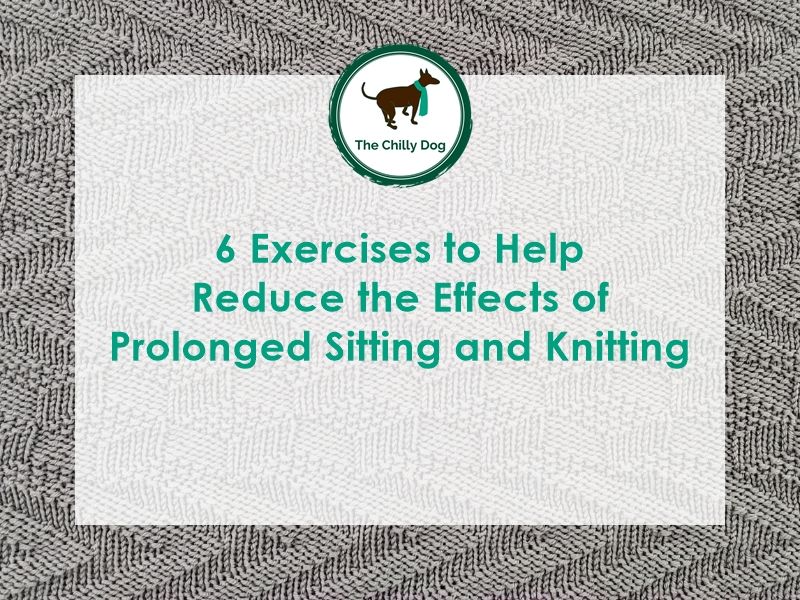
Article and photos by Diane Ghilardi - NASM Certified Personal Trainer, NASM Corrective Exercise Specialist, FAI Functional Aging Specialist, CETI Cancer Exercise Specialist, Certified in Training the Older Adult, TRX, Urban Poling Instructor, Balance and Fall Prevention
Do you notice after a session of knitting, reading, or watching television that you are stiff when you get up, and perhaps even need to walk a bit in order to straighten up? Some of you who follow me on Instagram @CablesandColors know that my day job is a Corrective Exercise and Functional Aging Specialist. I’m sharing some tips to counteract the sitting sessions that I know many people experience.
After sitting for long periods, whether it be at a desk, while you’re knitting or crocheting, or just a long car ride, doing some exercises - especially ones that focus on strengthening the posterior (back) part of your body, like your back, glutes (butt), and hamstrings (back of the thighs), while stretching the anterior (front) muscles, such as your hip flexors (where your leg meets the pelvis), pelvis, and chest can make a huge difference. Doing such moves can help counteract the tightness that happens when you're in a seated position, as well as strengthen the muscles that we need for good posture.
Speaking of good posture, while you’re working, to protect the lower back, it is better to sit in an upright chair with feet flat on the floor, rather than reclining onto a couch, where your lower back rounds. Sitting for long periods of time, especially with poor posture, makes your hip flexors tight, which causes the glutes (butt muscles) to lengthen to compensate. Over time, this compromises the ability of the gluteal muscles to activate properly. When your glutes can't do their job, other muscles in your body have to work harder, which can overwork them, leading to poor body alignment and aches. Tight hip flexors also make it harder for your pelvis to rotate properly and inhibited mobility in this area can cause compression and pain in the lower back.
Here are some very effective exercises to help counteract all that sitting. I’ve included images so you can see the positions to pay attention to. The first exercise, resistance band wide pulls, I do about every hour I am sitting.
The Exercises - All you need is a resistance band. Here’s my favorite one, and all of my clients have it. Do 12–15 reps of the first 5 moves, and hold the plank for 30 seconds. Rest for 20 seconds in between each move, or more if you feel you need it. Complete three total rounds of this circuit.
Resistance Band Wide Pulls
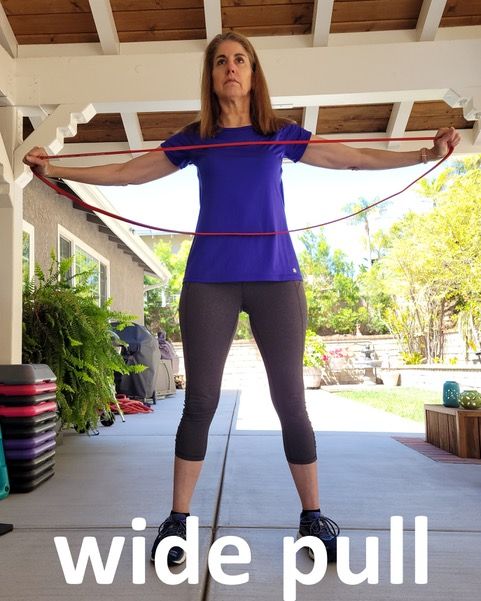
Stand and hold a resistance band in your hands at chest level or forehead level. Pull it wide with straight arms down across your chest using the back muscles (think of squeezing the shoulder blades together). Do not allow your lower back to arch as you pull. Do 15 - 20 repetitions.
Bird Dogs
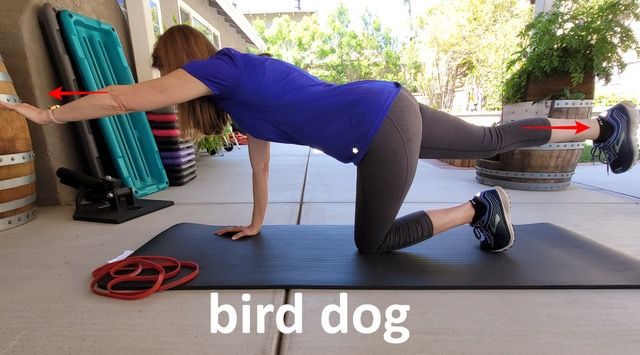
Perform bird dogs by getting on your hands and knees, placing your hands under your shoulders and your knees under your hips. While keeping your head and neck in a neutral position (in line with your spine), lift one arm in front of you and the opposite leg behind you, reaching in both directions with your limbs. Switch sides on the next repetition, lifting your other leg and the opposite arm. Imagine having a bowl of water on your lower back that you don’t want to spill - in other words, keep your pelvis parallel to the floor during the movement and don’t allow your hip to rotate. Do 10 - 12 on each side.
Glute Bridges
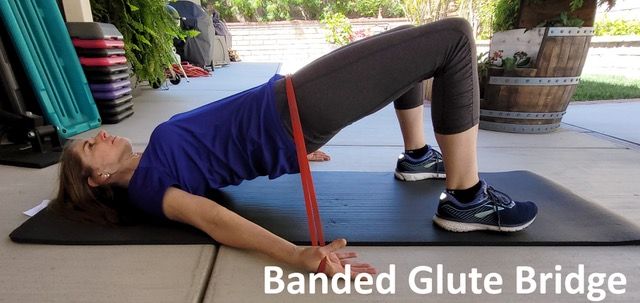
Lie face up on the floor, with your knees bent and feet flat on the ground directly below your knees. Keep your arms at your side with your palms facing up. Lift your hips off the ground until your knees, hips and shoulders form a straight line, being mindful not to flare your ribcage. Squeeze those glutes hard and keep your abs drawn in so you don’t overextend your back during the exercise. Hold the position for a couple of seconds before easing back down. Progress this move by placing a resistance band across the bottom of the pelvis where your leg meets your pelvis. Loop the band around the hands and keep the back of the hand against the floor, allowing the shoulder blades to also retract. Do 12 - 15 repetitions.
Bent-Over Row
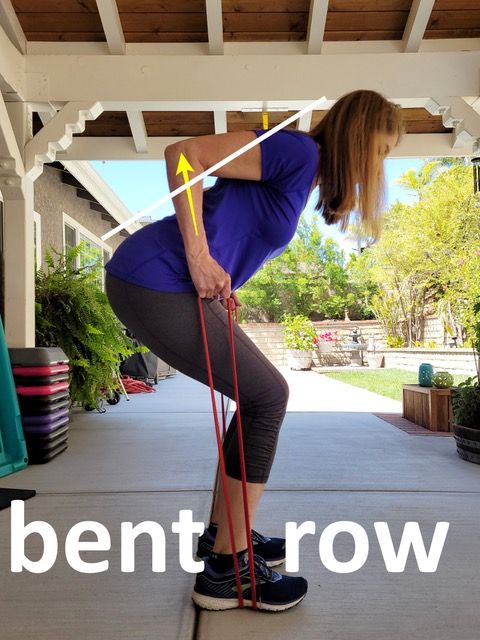
Stand on the center of your resistance band, holding both ends in your hands. Hinge at the hip, jutting your hips back and your chest toward the floor to obtain a flat back, knees slightly bent so that you don’t round your lower back. Keeping the elbows close to your sides, drive your elbows back to pull the band back at waist level, (not up). Retract the shoulder blades, squeezing them toward each other. Repeat 12 - 15 times.
Goblet Squat
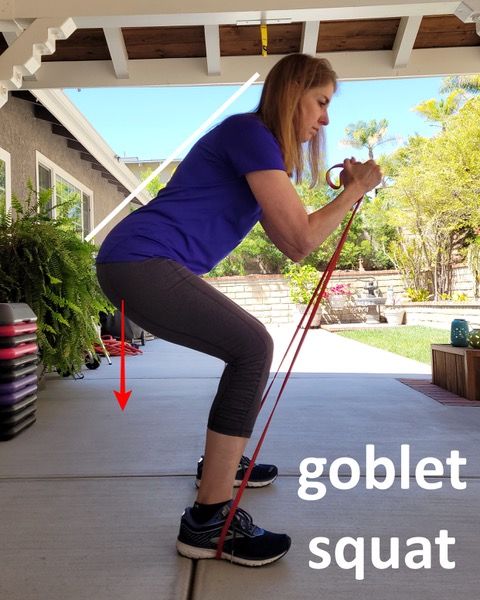
Stand with both feet on your resistance band with your feet hip or shoulder-width apart, toes pointed straight ahead or slightly angled outward. Hold the opposite end close to your chest with both hands together, creating resistance in the band when you are upright. Tighten your abs and squeeze your shoulder blades together. Sit your hips back and bend your knees to lower yourself into a squat. Keep the chest up as you squat and squat as low as you can while keeping your back straight (when your back starts to round, that's too low). Drive through the feet to “push the floor away” as you stand and squeeze your glutes as you return to a tall standing position, creating tension in the band.. Repeat 12 times. Alternative - do 10 to 20 sit-to-stands, just touching the chair with your bottom and with power, standing right back up and squeezing the glutes at the top. Be sure to hinge at the hip and push your bottom back with weight in the heels.
Plank
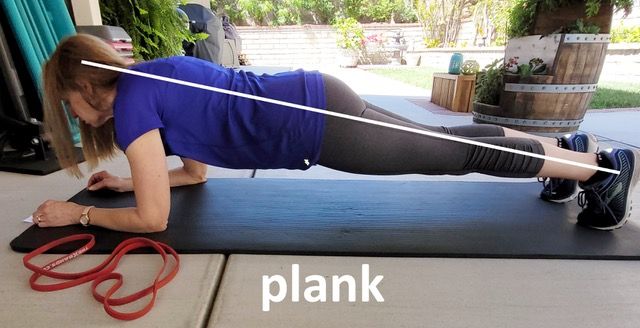
Can be done on your hands or your forearms if you have weak wrists. If you are not used to doing planks, start in an elevated position with hands or forearms on a chair. Plant hands directly under shoulders (slightly wider than shoulder width) like you’re about to do a push-up. Ground toes into the floor, squeeze glutes and keep your upper back engaged (not rounded) to stabilize your body. Your legs should be working, too — be careful not to lock or hyperextend your knees. Keep your neck in line with your spine by looking at a spot on the floor about a foot beyond your hands. Do not allow your lower back to droop or your butt to be much higher than your line. You want to be in as straight a line as possible with your body.
Connect With Diane
There's more to explore in the Learning Library!
